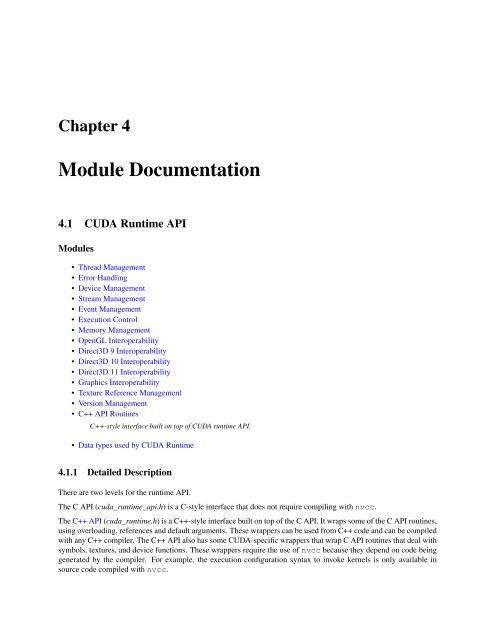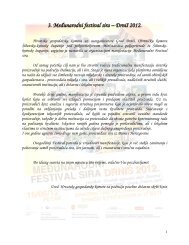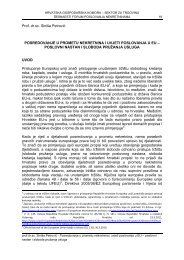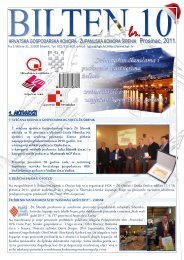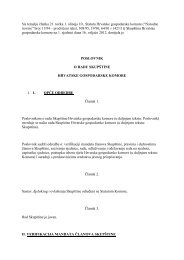- Page 1: NVIDIA CUDA Reference Manual Versio
- Page 4 and 5: ii CONTENTS 4.4.2.6 cudaSetDeviceFl
- Page 6 and 7: iv CONTENTS 4.9.2 Function Document
- Page 8 and 9: vi CONTENTS 4.17.2.3 cudaBindTextur
- Page 10 and 11: viii CONTENTS 4.26.2.2 cuModuleGetG
- Page 12 and 13: x CONTENTS 4.30.2.35 cuMemsetD2D16
- Page 14 and 15: xii CONTENTS 4.37.2.5 cuD3D10Resour
- Page 16 and 17: xiv CONTENTS 5.3 CUDA_MEMCPY2D_st S
- Page 18 and 19: 2 Deprecated List Global cudaD3D9Re
- Page 20 and 21: 4 Deprecated List Global cuD3D10Res
- Page 22 and 23: 6 Module Index Direct3D 9 Interoper
- Page 26 and 27: 10 Module Documentation 4.2 Thread
- Page 28 and 29: 12 Module Documentation Note: Note
- Page 30 and 31: 14 Module Documentation 4.4.2.2 cud
- Page 32 and 33: 16 Module Documentation Parameters:
- Page 34 and 35: 18 Module Documentation 4.5 Stream
- Page 36 and 37: 20 Module Documentation 4.6 Event M
- Page 38 and 39: 22 Module Documentation Parameters:
- Page 40 and 41: 24 Module Documentation 4.7 Executi
- Page 42 and 43: 26 Module Documentation 4.7.2.4 cud
- Page 44 and 45: 28 Module Documentation 4.8 Memory
- Page 46 and 47: 30 Module Documentation • cudaErr
- Page 48 and 49: 32 Module Documentation Returns: No
- Page 50 and 51: 34 Module Documentation 4.8.2.7 cud
- Page 52 and 53: 36 Module Documentation struct cuda
- Page 54 and 55: 38 Module Documentation 4.8.2.14 cu
- Page 56 and 57: 40 Module Documentation 4.8.2.17 cu
- Page 58 and 59: 42 Module Documentation Returns: No
- Page 60 and 61: 44 Module Documentation 4.8.2.22 cu
- Page 62 and 63: 46 Module Documentation See also: c
- Page 64 and 65: 48 Module Documentation kind - Type
- Page 66 and 67: 50 Module Documentation hOffset - S
- Page 68 and 69: 52 Module Documentation src - Sourc
- Page 70 and 71: 54 Module Documentation IMPORTANT N
- Page 72 and 73: 56 Module Documentation Parameters:
- Page 74 and 75:
58 Module Documentation 4.9 OpenGL
- Page 76 and 77:
60 Module Documentation target - Id
- Page 78 and 79:
62 Module Documentation Returns: cu
- Page 80 and 81:
64 Module Documentation 4.10.2.5 cu
- Page 82 and 83:
66 Module Documentation 4.11 Direct
- Page 84 and 85:
68 Module Documentation • The pri
- Page 86 and 87:
70 Module Documentation 4.12.2 Func
- Page 88 and 89:
72 Module Documentation flags - Par
- Page 90 and 91:
74 Module Documentation If pResourc
- Page 92 and 93:
76 Module Documentation • cudaD3D
- Page 94 and 95:
78 Module Documentation 4.13 Direct
- Page 96 and 97:
80 Module Documentation • Resourc
- Page 98 and 99:
82 Module Documentation Maps the co
- Page 100 and 101:
84 Module Documentation Parameters:
- Page 102 and 103:
86 Module Documentation Parameters:
- Page 104 and 105:
88 Module Documentation Parameters:
- Page 106 and 107:
90 Module Documentation Parameters:
- Page 108 and 109:
92 Module Documentation 4.16 Graphi
- Page 110 and 111:
94 Module Documentation • cudaGra
- Page 112 and 113:
96 Module Documentation 4.17 Textur
- Page 114 and 115:
98 Module Documentation Note: See a
- Page 116 and 117:
100 Module Documentation See also:
- Page 118 and 119:
102 Module Documentation 4.19 C++ A
- Page 120 and 121:
104 Module Documentation 4.19.2.2 t
- Page 122 and 123:
106 Module Documentation array - Me
- Page 124 and 125:
108 Module Documentation Note: Note
- Page 126 and 127:
110 Module Documentation 4.20 Data
- Page 128 and 129:
112 Module Documentation • typede
- Page 130 and 131:
114 Module Documentation cudaErrorI
- Page 132 and 133:
116 Module Documentation 4.21 CUDA
- Page 134 and 135:
118 Module Documentation 4.23 Devic
- Page 136 and 137:
120 Module Documentation • CU_DEV
- Page 138 and 139:
122 Module Documentation typedef st
- Page 140 and 141:
124 Module Documentation 4.24 Versi
- Page 142 and 143:
126 Module Documentation Returns: N
- Page 144 and 145:
128 Module Documentation Note: See
- Page 146 and 147:
130 Module Documentation 4.26 Modul
- Page 148 and 149:
132 Module Documentation Note: See
- Page 150 and 151:
134 Module Documentation optionValu
- Page 152 and 153:
136 Module Documentation 4.27 Strea
- Page 154 and 155:
138 Module Documentation 4.28 Event
- Page 156 and 157:
140 Module Documentation 4.28.2.4 c
- Page 158 and 159:
142 Module Documentation 4.29 Execu
- Page 160 and 161:
144 Module Documentation 4.29.2.3 c
- Page 162 and 163:
146 Module Documentation 4.29.2.7 c
- Page 164 and 165:
148 Module Documentation Parameters
- Page 166 and 167:
150 Module Documentation Copies mem
- Page 168 and 169:
152 Module Documentation unsigned i
- Page 170 and 171:
154 Module Documentation 4.30.2.3 c
- Page 172 and 173:
156 Module Documentation 4.30.2.5 c
- Page 174 and 175:
158 Module Documentation The pitch
- Page 176 and 177:
160 Module Documentation CUdevicept
- Page 178 and 179:
162 Module Documentation For device
- Page 180 and 181:
164 Module Documentation CUdevicept
- Page 182 and 183:
166 Module Documentation If dstMemo
- Page 184 and 185:
168 Module Documentation If srcMemo
- Page 186 and 187:
170 Module Documentation cuMemcpy3D
- Page 188 and 189:
172 Module Documentation 4.30.2.18
- Page 190 and 191:
174 Module Documentation Returns: N
- Page 192 and 193:
176 Module Documentation Returns: N
- Page 194 and 195:
178 Module Documentation 4.30.2.28
- Page 196 and 197:
180 Module Documentation The CUDA c
- Page 198 and 199:
182 Module Documentation See also:
- Page 200 and 201:
184 Module Documentation 4.30.2.38
- Page 202 and 203:
186 Module Documentation 4.31.1 Det
- Page 204 and 205:
188 Module Documentation 4.31.2.6 c
- Page 206 and 207:
190 Module Documentation Pitch - Li
- Page 208 and 209:
192 Module Documentation Parameters
- Page 210 and 211:
194 Module Documentation See also:
- Page 212 and 213:
196 Module Documentation 4.33 OpenG
- Page 214 and 215:
198 Module Documentation Parameters
- Page 216 and 217:
200 Module Documentation Note: Note
- Page 218 and 219:
202 Module Documentation 4.34 Direc
- Page 220 and 221:
204 Module Documentation The Flags
- Page 222 and 223:
206 Module Documentation 4.35.2 Fun
- Page 224 and 225:
208 Module Documentation • Textur
- Page 226 and 227:
210 Module Documentation 4.35.2.6 c
- Page 228 and 229:
212 Module Documentation Note: Note
- Page 230 and 231:
214 Module Documentation 4.36 Direc
- Page 232 and 233:
216 Module Documentation • CU_GRA
- Page 234 and 235:
218 Module Documentation Maps the c
- Page 236 and 237:
220 Module Documentation If pResour
- Page 238 and 239:
222 Module Documentation 4.37.2.6 c
- Page 240 and 241:
224 Module Documentation Note: Note
- Page 242 and 243:
226 Module Documentation 4.38 Direc
- Page 244 and 245:
228 Module Documentation Not all Di
- Page 246 and 247:
230 Module Documentation resources
- Page 248 and 249:
232 Module Documentation Returns: N
- Page 250 and 251:
234 Module Documentation 4.40 Data
- Page 252 and 253:
236 Module Documentation • enum C
- Page 254 and 255:
238 Module Documentation • typede
- Page 256 and 257:
240 Module Documentation 4.40.2.3 t
- Page 258 and 259:
242 Module Documentation 4.40.3.3 e
- Page 260 and 261:
244 Module Documentation CU_DEVICE_
- Page 262 and 263:
246 Module Documentation Enumerator
- Page 264 and 265:
248 Data Structure Documentation 5.
- Page 266 and 267:
250 Data Structure Documentation 5.
- Page 268 and 269:
252 Data Structure Documentation So
- Page 270 and 271:
254 Data Structure Documentation 5.
- Page 272 and 273:
256 Data Structure Documentation 5.
- Page 274 and 275:
258 Data Structure Documentation 5.
- Page 276 and 277:
260 Data Structure Documentation 5.
- Page 278 and 279:
Index C++ API Routines, 102 Context
- Page 280 and 281:
264 INDEX CUDA_TYPES, 239 CU_MEMHOS
- Page 282 and 283:
266 INDEX CUDA_ERROR_UNMAP_FAILED C
- Page 284 and 285:
268 INDEX CUDA_TYPES, 239 cudaBindT
- Page 286 and 287:
270 INDEX cudaGetLastError CUDART_E
- Page 288 and 289:
272 INDEX cudaGraphicsRegisterFlags
- Page 290 and 291:
274 INDEX CUdevice_attribute CUDA_T
- Page 292 and 293:
276 INDEX CUMEM, 164 cuMemcpy3DAsyn
- Page 294:
Notice ALL NVIDIA DESIGN SPECIFICAT


